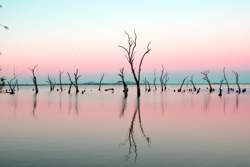Water Storage Levels
Last Updated
26/04/2024
| Current Volume |
42034 |
| % of Capacity |
81.40 |
| Capacity (ML) |
51640 |
|
94.0%
|
95.6%
|
90.0%
|
89.6%
|
81.4%
|
| Dec |
Jan |
Feb |
Mar |
Apr |
Facts & Figures
| Name |
Ghow (Kow) Swamp |
| Stream |
|
| Year of Completion |
|
| Construction |
|
| Full Supply Level |
83.1 m AHD |
| Capacity |
50,910 ML |
| Area Submerged |
ha |
| Main Embankment Length |
m |
| Main Embankment Height |
m |
| Hydro-electric Generation |
MW |
News and Announcements
The Minister for Treaty and First Peoples has used her powers under section 103 of the Aboriginal Heritage Act 2006 to make an Ongoing Protection Decl...
About Ghow (Kow) Swamp
 Ghow Swamp
Ghow Swamp
Ghow Swamp is a large water storage with a circumference of 15 kilometres and a capacity of 50,910 megalitres.
Ongoing Protection Declaration
The Minister for Treaty and First Peoples has used her powers under section 103 of the Aboriginal Heritage Act 2006 to make an Ongoing Protection Declaration (the Declaration) for Ghow Swamp Aboriginal Place. The declaration can be viewed on the First Peoples - State Relations website
Location
Ghow Swamp is located 3km south of Leitchville and 6 kms from Gunbower and is in the Shire of Campaspe. Mount Hope overlooks Ghow Swamp.
History
In earlier years Ghow Swamp was operated as an off river storage by an amalgamation of Irrigation Trusts and in 1900 the full supply level of the swamp was increased to that level used today.
The completion of the Torrumbarry Weir in 1923 together with the construction of the National Channel headworks provided an assured gravity supply to Ghow Swamp and the rest of the system. Major remodelling of the natural carrier system was carried out in the 1960s lowering the running level of the Pyramid Creek from Ghow Swamp to Kerang Weir.
Interesting Information
Ghow Swamp remains of the Pleistocene epoch aboriginal population are re-dated to more than 20,000 years old.
The Ghow Swamp remains are the world’s largest single population of human remains from the late Pleistocene era (120,000–10,000 years).
The swamp’s name comes from the Aboriginal word Ghow which describes the white gypsum soil found at Ghow Swamp.
Operations
Ghow Swamp is an integral part of the Torrumbarry System, it allows water to be stored for use during periods of high demand, thus providing a better level of service to G-MW customers and avoiding periods of rationing during these times.
Ghow Swamp and Kangaroo Lake, with a total of 27,000 megalitres of useable storage, are used as in-system storage to overcome the long delay in receiving water from Lake Hume. Ghow Swamp is used to supply the system on three to four day notification from customers. When the water arrives from Hume, Ghow Swamp and Kangaroo Lake are then replenished.
In the investigation stage of the off river storage project, which originally began as the Lake Boga Storage Project, it quickly became apparent that Lake Boga alone was not going to provide enough storage. Further studies then included Kangaroo Lake and then Lake Charm and it became the Mid Murray Storage Project. It then was a natural progression to include Kow Swamp as the project was renamed the Victorian Mid Murray Storages.
The operation of Ghow Swamp will be virtually unchanged by its inclusion into the Victoria Mid Murray Storages.
Recreation and Tourism at Ghow (Kow) Swamp
Facilities Available

Large Grassed Area

Car Parking

Fishing
Please observe all signs and directions around our storages for information on recreational activities. Refer to the Land and On-Water Management Plan (if provided above) for detailed information on the facilities available.
Further Information
Kow (Ghow) Swamp is a popular fishing spot although it has dense tree cover and snags. Bank fishing at the inlet channel is popular.
Caravan Parks, Camping Grounds and Accommodation
For information on local camping grounds, caravan parks and accommodation, please contact the local tourist information centre.